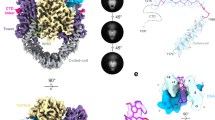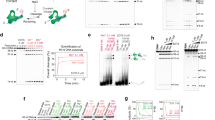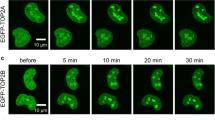Abstract
We recently reported an interaction between the p14ARF protein and human topoisomerase I (Topo I) resulting in the stimulation of the relaxation activity of Topo I. Our data showed that the complex between the two proteins was located within the nucleolus. In the present work, we have investigated the regions of p14ARF involved in this interaction by using targeted point mutagenesis and deletion mutants. A region encompassing exon 2-encoded sequence was required for physical binding of p14ARF to Topo I as well as for stimulatory activity of the enzyme. Exon 1β-encoded segment was not implicated in the interaction. Moreover, among p14ARF point mutants selected for their high conservation among different mammalian species, mutant p14ARF (RR87, 88AA) did not stimulate Topo I in spite of its association with the enzyme, suggesting its direct implication in the functional activity of ARF. In contrast, one mutant, p14ARF (R71A), was more efficient than wild-type protein to activate Topo I, suggesting that this residue is a key element to modulate Topo I activity. Finally, only ARF–Topo I complexes containing p14ARF exon 2 segment were found to be localized in the nucleolus, suggesting that this subnuclear location is linked to the biological function of the ARF–Topo I complex.
This is a preview of subscription content, access via your institution
Access options
Subscribe to this journal
Receive 50 print issues and online access
$259.00 per year
only $5.18 per issue
Buy this article
- Purchase on Springer Link
- Instant access to full article PDF
Prices may be subject to local taxes which are calculated during checkout







Similar content being viewed by others
References
Carnero A, Hudson JD, Price CM and Beach DH . (2000). Nat. Cell Biol., 2, 148–154.
Della Valle V, Duro D, Bernard O and Larsen CJ . (1997). Oncogene, 15, 2475–2481.
Gazzeri S, Della Valle V, Chaussade L, Brambilla C, Larsen CJ and Brambilla E . (1998). Cancer Res. 58, 3926–3931.
Guldner HH, Szostecki C, Vosberg HP, Lakomek HJ, Penner E and Bautz FA . (1986). Chromosoma, 94, 132–138.
Hahn WC and Weinberg RA . (2002). Nat. Rev. Cancer, 2, 331–341.
Higuchi R, Krummel B and Saiki RK . (1988). Nucleic Acids Res., 16, 7351–7367.
Kamijo T, Zindy F, Roussel MF, Quelle DE, Downing JR, Ashmun RA, Grosveld G and Sherr CJ . (1997). Cell, 91, 649–659.
Karayan L, Riou JF, Séité P, Migeon J, Cantereau A and Larsen CJ . (2001). Oncogene, 20, 836–848.
Kubbutat MH, Jones SN and Vousden KH . (1997). Nature, 6630, 299–303.
Kurokawa K, Tanaka T and Kato J . (1999). Oncogene, 18, 2718–2727.
Llanos S, Clark PA, Rowe J and Peters G . (2001). Nat. Cell Biol., 3, 445–452.
Rizos H, Darmanian AP, Mann GJ and Kefford RF . (2000). Oncogene, 19, 2978–2985.
Rossi F, Labourier E, Forné T, Divita G, Derancourt J, Riou JF, Antoine E, Cathala G, Brunel C and Tazi J . (1996). Nature, 381, 80–82.
Serrano M, Hannon GJ and Beach D . (1993). Nature, 366, 704–707.
Sherr CJ . (1998). Genes Dev., 12, 2984–2991.
Sherr CJ . (2001). Nat. Rev. Mol. Cell. Biol., 10, 731–737 (review).
Vaughn JL, Goodwin RH, Tompkins GJ and McCawley P . (1977). In Vitro, 13, 213–217.
Weber JD, Taylor LJ, Roussel MF, Sher CJ and Bar-Sagi D . (1999). Nat. Cell Biol., 1, 20–26.
Weber JD, Jeffers JR, Tehg JE, Randle DH, Lozano G, Roussel MF, Scherr CJ and Zambetti GP . (2000). Genes Dev., 14, 2358–2365.
Wei W, Hemmer RM and Sedivy JM . (2001). Mol. Cell Biol., 21, 6748–6757.
Zhang Y and Xiong Y . (1999). Mol. Cell., 3, 579–591.
Zhang Y, Xiong Y . (2001). Cell Growth Differ., 12, 175–186.
Acknowledgements
This work was supported by a Grant (ARC 5915) from the Association pour la Recherche centre le Cancer (ARC) Villejuif, France. We are grateful to Dr Gazzeri for providing us with GST constructions. We also acknowledge the help of Dr A Cantereau for confocal microscopy studies.
Author information
Authors and Affiliations
Corresponding author
Rights and permissions
About this article
Cite this article
Olivier, A., Lucie, K., Jean-François, R. et al. Delineation of the domains required for physical and functional interaction of p14ARF with human topoisomerase I. Oncogene 22, 1945–1954 (2003). https://doi.org/10.1038/sj.onc.1206214
Received:
Revised:
Accepted:
Published:
Issue Date:
DOI: https://doi.org/10.1038/sj.onc.1206214
Keywords
This article is cited by
-
DNA damage, p14ARF, Nucleophosmin (NPM/B23), and cancer
Journal of Molecular Histology (2006)
-
ATM activity contributes to the tumor-suppressing functions of p14ARF
Oncogene (2004)



